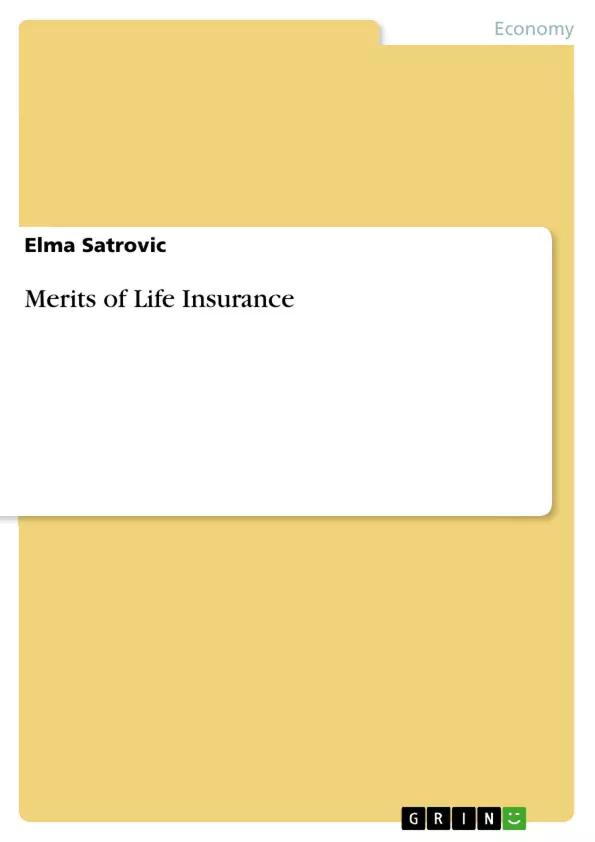In this book linear panel data estimators are employed to investigate the relationship between life insurance and economic growth. This study contributes to previous studies by using Maximum likelihood estimation of dynamic panel that was not used in previous studies concerning the aforementioned relationship; by controlling for number of factors thought to influence economic growth; by referring to a much larger number of countries and by exploring the relationship between life insurance and economic growth while controlling for the degree of financial sector development, as well as for the regional and income disparities. Sixteen models that explore the impact of control variables integrated singly in the equations and an integrated model that controls for the impact of all key variables are estimated. Empirical results reveal a significant positive relationship between life insurance and economic growth in models -. Education is reported to have a positive impact on economic growth. Government spending is found to have a negative impact on economic growth, while model reports that inflation has a negative impact on economic growth. Trade openness is not reported to have a significant impact on economic growth in model. Model reveals a significant positive impact of banking sector on economic growth; significant negative impact of non-life insurance sector while stock market is not reported to have a significant impact. An integrated model that controls for the impact of all key variables gives a strong support to the results obtained in models -. Results of models - that attempt to control for the importance of regional disparities indicate that a significant positive relationship between life insurance and economic growth is reported for all regions but South Asia and North America. Models - that additionally control for differences in levels of development reveal a significant positive relationship between life insurance and economic growth in high-, middle- and low-income countries.
Inhaltsverzeichnis (Table of Contents)
- INTRODUCTION
- Description of the research
- Research objectives
- Research question and hypotheses
- Research methodology
- LINEAR PANEL DATA ESTIMATORS
- Introduction to panel data
- Advantages of panel data
- Limitations of panel data
- Heterogeneity bias
- Selectivity bias
- Simultaneity bias
- Static panel data model specification
- Pooled regression
- The fixed effects model
- The random effects model
- Linear static panel data estimators
- Ordinary least squares estimator
- Least squares dummy variables estimator
- Generalized least squares estimator
- Analysis of models estimated using linear static panel data estimators
- Specification test
- Violations of Gauss-Markov assumptions in the classical linear regression model
- Linear dynamic panel data estimators
- Arellano and Bond estimator
- Arellano and Bover estimator
- Maximum likelihood estimator
- Analysis of models estimated using linear dynamic panel data estimators
- THEORETICAL OVERVIEW OF THE RELATIONSHIP BETWEEN LIFE INSURANCE AND ECONOMIC GROWTH
- Growth theory
- Brief history of life insurance
- Main characteristics of life insurance
- Actuarial basis of life insurance
- Determinants of life insurance development
- Types of life insurance products in actuarial mathematics literature
- Gross premium
- Actuarial provision
- Financial intermediaries and economic growth
- Life insurance companies as financial intermediaries
- Causality between life insurance activity and economic growth
- Joint role of banks and insurers in contributing to economic growth
- Overview of the empirical studies
- Theoretical development of Solow-Swan model
- Solow-Swan model
- Revised Solow-Swan model
- STATIC PANEL DATA ANALYSIS
- Data and modeling exogenous relationship between life insurance activity and economic growth
- Exogenous relationship between life insurance and economic growth
- Variables
- The specification of models
- The sample selection
- Simultaneity bias in modeling the relationship between life insurance activity and economic growth
- Results of the research
- Descriptive statistics
- Basic model
- First extended model
- Second extended model
- Third extended model
Zielsetzung und Themenschwerpunkte (Objectives and Key Themes)
This research aims to investigate the relationship between life insurance activity and economic growth. It utilizes panel data analysis techniques to explore the impact of life insurance on economic development. The study focuses on both static and dynamic panel data models, examining the potential for both exogenous and endogenous relationships between these variables.
- The influence of life insurance on economic growth
- The role of financial intermediaries in economic development
- The application of panel data analysis techniques in economic research
- The impact of static and dynamic panel data models on understanding economic relationships
- The identification and mitigation of potential biases in panel data analysis
Zusammenfassung der Kapitel (Chapter Summaries)
- INTRODUCTION: This chapter introduces the research topic, its objectives, and the methodology employed. It also outlines the research questions and hypotheses guiding the investigation.
- LINEAR PANEL DATA ESTIMATORS: This chapter provides a comprehensive overview of panel data analysis techniques, including its advantages, limitations, and various model specifications. It explores both static and dynamic panel data estimators and discusses their application in economic research.
- THEORETICAL OVERVIEW OF THE RELATIONSHIP BETWEEN LIFE INSURANCE AND ECONOMIC GROWTH: This chapter presents a theoretical framework for understanding the relationship between life insurance and economic growth. It reviews relevant growth theories, the historical development of life insurance, and the role of life insurance companies as financial intermediaries.
- STATIC PANEL DATA ANALYSIS: This chapter delves into the empirical analysis of the relationship between life insurance activity and economic growth using static panel data models. It explores various model specifications, examines potential biases, and presents the results of the research.
Schlüsselwörter (Keywords)
The primary keywords and focus topics of this research include life insurance, economic growth, panel data analysis, static and dynamic panel data models, financial intermediaries, heterogeneity bias, selectivity bias, simultaneity bias, and Solow-Swan model.
- Citation du texte
- Elma Satrovic (Auteur), 2018, Merits of Life Insurance, Munich, GRIN Verlag, https://www.grin.com/document/439587



